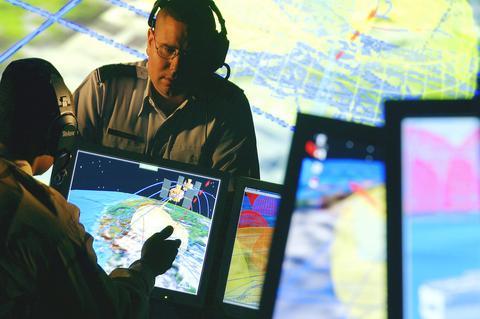Lockheed Martin doesn't run the US. But it does help run a breathtakingly big part of it.
Over the last decade, Lockheed, the nation's largest military contractor, has built a formidable information-technology empire that now stretches from the Pentagon to the post office. It sorts your mail and totals your taxes. It cuts Social Security checks and counts the US census. It runs space flights and monitors air traffic. To make all that happen, Lockheed writes more computer code than Microsoft.

PHOTO: LOCKHEED MARTIN CORPORATION
Of course, Lockheed, based in Bethesda, Maryland, is best known for its weapons, which are the heart of the US arsenal. It builds most of the nation's warplanes. It creates rockets for nuclear missiles, sensors for spy satellites and scores of other military and intelligence systems. The Pentagon and the CIA might have difficulty functioning without the contractor's expertise.
But in the post-9/11 world, Lockheed has become more than just the biggest corporate cog in what Dwight D. Eisenhower called the military-industrial complex. It is increasingly putting its stamp on the nation's military policies, too.
Lockheed stands at "the intersection of policy and technology," and that "is really a very interesting place to me," said its new chief executive, Robert Stevens, a tightly wound former Marine. "We are deployed entirely in developing daunting technology," he said, and that requires "thinking through the policy dimensions of national security as well as technological dimensions."
To critics, however, Lockheed's deep ties with the Pentagon raise some questions.
"It's impossible to tell where the government ends and Lockheed begins," said Danielle Brian of the Project on Government Oversight, a nonprofit group in Washington that monitors government contracts. "The fox isn't guarding the henhouse. He lives there."
No contractor is in a better position than Lockheed to do business in Washington. Nearly 80 percent of its revenue comes from the US government. Most of the rest comes from foreign military sales, many financed with tax dollars. And former Lockheed executives, lobbyists and lawyers hold crucial posts at the White House and the Pentagon, picking weapons and setting policies.
Obviously, war and crisis have been good for business. The Pentagon's budget for buying new weapons rose by about a third over the last three years, to US$81 billion in fiscal 2004, up from US$60 billion in 2001. Lockheed's sales also rose by about a third, to nearly US$32 billion last year, from US$24 billion in 2001. It was the No. 1 recipient of Pentagon primary contracts, with US$21.9 billion in fiscal 2003. Boeing had US$17.3 billion, Northrop Grumman had US$11.1 billion and General Dynamics had US$8.2 billion.
Lockheed also has many tens of billions of dollars in future orders on its books. The company's stock has tripled in the last four years, to just under US$60.
"It used to be just an airplane company," said John Pike, a longtime military analyst and director of GlobalSecurity.org, a research organization in Alexandria, Virginia. "Now it's a warfare company. It's an integrated solution provider. It's a one-stop shop. Anything you need to kill the enemy, they will sell you."
The melding of military and intelligence programs, information-technology and domestic security spending began in earnest after the Sept. 11 attacks. Lockheed was perfectly positioned to take advantage of the shift. When the US government decided a decade ago to let corporate America handle federal information technology, Lockheed leapt at the opportunity. Its information-technology sales have quadrupled since 1995, and, for all those years, Lockheed has been the No. 1 supplier to the federal government, which now outsources 83 percent of its IT work.
Lockheed has taken over the job of making data flow throughout the government, from the FBI's long-dysfunctional computer networks to the Department of Health and Human Services system for tracking child support. The company just won a US$525 million contract to fix the Social Security Administration's information systems. It has a US$87 million contract to make computers communicate and secrets stream throughout the Department of Homeland Security. On top of all that, the company is helping to rebuild the US Coast Guard -- a US$17 billion program -- and to supply, under the Patriot Act, biometric identity cards for 6 million Americans who work in transportation.
Lockheed is also the strongest corporate force driving the Pentagon's plans for "net-centric warfare": the big idea of fusing military, intelligence and weapons programs through a new military Internet, called the Global Information Grid, to give American soldiers throughout the world an instant picture of the battlefield around them. "We want to know what's going on anytime, anyplace on the planet," said Lorraine Martin, vice president and deputy of the company's Joint Command, Control and Communications Systems division.
Lockheed's global reach is also growing. Its "critical mass" of salesmanship lets it "produce global products for a global marketplace," said Robert Trice Jr., the senior vice president for corporate business development. With its dominant position in fighter jets, missiles, rockets and other weapons, Lockheed's technology will drive the security spending for many US allies in coming decades. Lockheed now sells aircraft and weapons to more than 40 countries. The US taxpayer is financing many of those sales. For example, Israel spends much of the US$1.8 billion in annual military aid from the US to buy F-16 warplanes from Lockheed.
In the US, where national security spending now surpasses US$500 billion a year, Lockheed's dominance is growing. Its own executives say the concentration of power among military contractors is more intense than in any other sector of business outside banking. Three or four major companies -- Lockheed, General Dynamics, Northrop Grumman and arguably Boeing -- rule the industry. They often work like general contractors building customized houses, farming out the painting, the floors and the cabinets to smaller subcontractors and taking their own share of the money.
And, after 9/11, cost is hardly the most important variable for Pentagon planners. Lockheed has now won approval to build as many F-22 fighter jets as possible. The current price, US$258 million apiece, easily makes the F-22 the most expensive fighter jet in history.
Stevens, whose compensation last year as Lockheed's chief operating officer was more than US$9.5 million, says cost is essentially irrelevant when national security is at stake. "Some folks might think, well, here's a fighter that costs a lot," he said. "This is not a business where in the purest economical sense there's a broad market of supply and demand and price and value can be determined in that exchange. It's more challenging to define its value."

TRAGEDY STRIKES TAIPEI: The suspect died after falling off a building after he threw smoke grenades into Taipei Main Station and went on a killing spree in Zhongshan A 27-year-old suspect allegedly threw smoke grenades in Taipei Main Station and then proceeded to Zhongshan MRT Station in a random killing spree that resulted in the death of the suspect and two other civilians, and seven injured, including one in critical condition, as of press time last night. The suspect, identified as a man surnamed Chang Wen (張文), allegedly began the attack at Taipei Main Station, the Taipei Fire Department said, adding that it received a report at 5:24pm that smoke grenades had been thrown in the station. One man in his 50s was rushed to hospital after a cardiac arrest

PUBLIC SAFETY: The premier said that security would be tightened in transport hubs, while President Lai commended the public for their bravery The government is to deploy more police, including rapid response units, in crowded public areas to ensure a swift response to any threats, President William Lai (賴清德) said yesterday after a knife attack killed three people and injured 11 in Taipei the previous day. Lai made the remarks following a briefing by the National Police Agency on the progress of the investigation, saying that the attack underscored the importance of cooperation in public security between the central and local governments. The attack unfolded in the early evening on Friday around Taipei Main Station’s M7 exit and later near the Taipei MRT’s Zhongshan

SAFETY FIRST: Double the number of police were deployed at the Taipei Marathon, while other cities released plans to bolster public event safety Authorities across Taiwan have stepped up security measures ahead of Christmas and New Year events, following a knife and smoke bomb attack in Taipei on Friday that left four people dead and 11 injured. In a bid to prevent potential copycat incidents, police deployments have been expanded for large gatherings, transport hubs, and other crowded public spaces, according to official statements from police and city authorities. Taipei Mayor Chiang Wan-an (蔣萬安) said the city has “comprehensively raised security readiness” in crowded areas, increased police deployments with armed officers, and intensified patrols during weekends and nighttime hours. For large-scale events, security checkpoints and explosives

ON ALERT: Taiwan’s partners would issue warnings if China attempted to use Interpol to target Taiwanese, and the global body has mechanisms to prevent it, an official said China has stationed two to four people specializing in Taiwan affairs at its embassies in several democratic countries to monitor and harass Taiwanese, actions that the host nations would not tolerate, National Security Bureau (NSB) Director-General Tsai Ming-yen (蔡明彥) said yesterday. Tsai made the comments at a meeting of the legislature’s Foreign Affairs and National Defense Committee, which asked him and Minister of National Defense Wellington Koo (顧立雄) to report on potential conflicts in the Taiwan Strait and military preparedness. Democratic Progressive Party (DPP) Legislator Michelle Lin (林楚茵) expressed concern that Beijing has posted personnel from China’s Taiwan Affairs Office to its